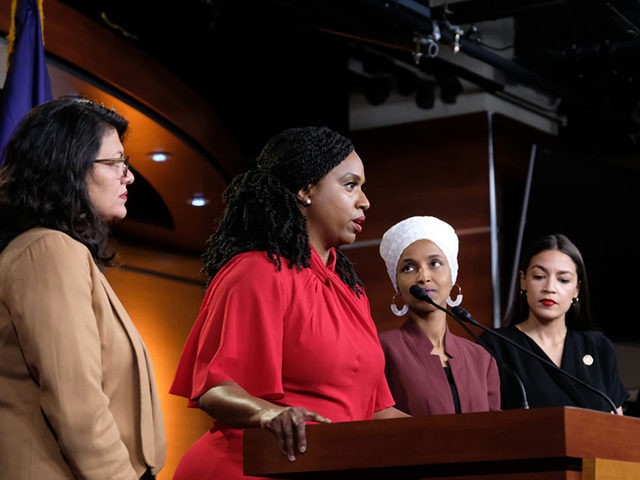Democrats and teachers’ unions have demanded $305 billion in coronavirus aid, claiming the taxpayer funds are necessary to reopen public schools “safely.”
In a June 1 letter to congressional leaders of both parties, over 100 Democrat lawmakers outlined the need for federal aid in the reopening process:
Given the decreases in state revenues that support education funding and the new expenses facing schools in adapting to the new learning environment, state education budgets across the U.S. will struggle to meet the long-term demands of providing high-quality learning to all their students.
“States will have to be spending 20 percent more on schools,” said Randi Weingarten, president of the American Federation of Teachers, said, according to CNN. “If they don’t, it means we’ll have more remote education next year.”
“Anybody who’s not seriously negotiating right now doesn’t really want to reopen schools for children,” she added.
Weingarten, like most Democrats, expects heavy involvement in education from the federal government.
“In any normal administration, either Democrat or Republican, the federal government would have a role in giving out real guidance,” she commented.
In the previous CARES (Coronavirus Aid, Relief, and Economic Security) Act, K-12 and higher education received $30 billion.
Education Week reported on the “tug of war” over the next coronavirus aid package:
On one side might be Republicans who could focus on the health and safety protocols and supplies needed to help schools resume in-person classes, but not a huge range of needs. On the other side might be Democrats who could try to expand the focus of a bailout to priorities like saving teacher jobs, infrastructure, and broadband internet access.
Though President Donald Trump has made clear he wants to see schools open in the fall, the Department of Education has also stressed the importance of local decision-making.
Angela Morabito, spokeswoman for Secretary of Education Betsy DeVos, told CNN, “the Secretary has been focused on empowering local leaders with the funding, flexibility, and support they need to make decisions that are best for their students and teachers.”
“There is a wealth of resources and information for local leaders on our COVID-19 website, and the Secretary has been in constant communication with state chiefs, governors, and local educators,” Morabito added.
In Montana, officials are trying to keep the focus on local control of education, reported the Billings Gazette.
“There is an unfortunate history of the federal government playing a heavy hand … often in onerous ways that limit local control,” said Lance Melton, who heads the Montana School Boards Association.
Reacting to the president’s call for schools to open, Superintendent of Public Instruction Elsie Arntzen said, “I believe that what the president was saying is ‘let’s put some stability into a discussion of having schools open.’”
Arntzen added that Montana schools would be able to plan for their own reopening policies.
Similarly, in Wyoming, Gov. Mark Gordon (R) said local officials will decide how to reopen schools.
“Wyoming is a state which values local control,” Gordon said. “We want to make sure that we have the flexibility that allows school districts who, after all, know best.”
As Bloomberg notes, the U.S. spends approximately $700 billion annually on K-12 education. Yet, despite this level of investment in government schools, recent results of the National Assessment of Educational Progress (NAEP), also known as the Nation’s Report Card, found U.S. fourth and eighth graders made “no progress” in either mathematics or reading over the past decade, while attending school, in person.
Government schools claim to be, first and foremost, all about “equity,” yet the achievement gap, while students have been taught, in person, has widened between higher performing, mostly white and Asian students, and lower performing, mostly black and Hispanic students.
Dr. Peggy Carr, associate commissioner of the National Center for Education Statistics, noted the same Nation’s Report Card assessment results for students actually attending school:
Over the past decade, there has been no progress in either mathematics or reading performance, and the lowest-performing students are doing worse. In fact, over the long term in reading, the lowest-performing students—those readers who struggle the most—have made no progress from the first NAEP administration almost 30 years ago.
“The tests have served as a steady reminder that no matter the increase in federal investment in K–12 schools or the size of the Cabinet-level agency, Washington has not improved student achievement over time,” read a recent report by the Heritage Foundation.
Frederick Hess, the director of education policy studies at the American Enterprise Institute (AEI), told CNN regarding demands for billions more in coronavirus aid, “schools should be able to demonstrate that they’re actually teaching kids in a reasonable, robust way in order to keep the money.”
Hess suggested that, if Congress provides aid to schools in a way similar to that of the Paycheck Protection Program (PPP), local school districts that receive funding to reopen should meet certain education standards or risk losing future federal taxpayer dollars.
Democrats in the House, however, pushed by teachers’ unions, want to ensure the centralized, federal education bureaucracy is held up. They wrote to congressional leaders:
This pandemic is causing significant declines in state income and sales tax and other revenues that substantially fund our nation’s public schools … Without significant federal support, our states will struggle to support their public schools, and our students will feel the brunt of the result.
Union leaders are condemning the Trump administration’s push to reopen schools, despite the fact that 56 percent of K-12 parents want full-time, in-person attendance in the fall, according to a Gallup poll in June.
Cheryl Bost, president of the Maryland State Education Association, told WBAL Wednesday that, regardless of whether education happens in person or virtually, teachers will need more funds for safety, which apparently includes items such as Chromebooks.
“Our educators want to be with their students, they want to educate but we want to be safe,” she said.

COMMENTS
Please let us know if you're having issues with commenting.